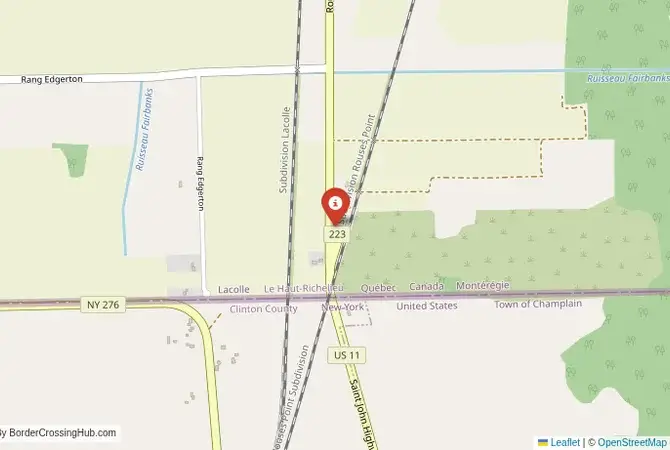
Approximate Border Location
Border Countries
- 🇺🇸United States
- 🇨🇦Canada
Border Cities
- 🇺🇸Champlain, NY / Rouses Point
- 🇨🇦Noyes / Lacolle border area
Wait Times
15-60 min for pedestrians/vehicles
Operating Hours
Open 24 hours
Crossing Types
Pedestrians, vehicles, commercial
Border Type
Land crossing via road
Peak Times
Mornings (7-10 AM), weekends
Daily Crossings
~8000 travelers/vehicles
Currency Exchange
Available near Champlain (USD, CAD)
Safety Information
Generally safe, busy traffic
Languages Spoken
English
Accessibility Features
Ramps, elevators
About Champlain, NY / Rouses Point & Noyes / Lacolle border area
A Bustling Northern Gateway
The Champlain-Noyes border crossing, also known as Champlain Border or Lacolle Port, connects Champlain, New York, with Lacolle, Quebec, via Interstate 87 and Quebec Autoroute 15. This 24/7 crossing is one of the busiest in New York, linking Montreal (45 minutes north) and Plattsburgh (10 minutes south). It handles heavy commercial and passenger traffic, making it a key route for trade and tourism. Foreign visitors should check U.S. Customs and Border Protection (CBP) or Canada Border Services Agency (CBSA) updates, as scams and congestion are concerns in peak seasons.
Historical Background
Established in the early 1800s, this crossing grew alongside the Champlain Valley’s trade routes. Named for Samuel de Champlain, it supported early fur and timber trade, with Lacolle’s mills drawing settlers. During the War of 1812, the area saw skirmishes, and in the 1920s, Prohibition fueled smuggling—think rumrunners dodging patrols along the Richelieu River. The 1960s brought highway expansions, boosting its role as a commercial hub. Today, it’s a vital link, handling thousands of vehicles daily, though occasional trade disputes add tension.
Before Crossing
Crossing borders gets messy sometimes, think political flare-ups or gates shutting fast. Good travel insurance is a must for handling doctor visits, trip disruptions, or security scares. Don’t get caught unprepared. To find a policy that’s got your back, check out reliable plans today for peace of mind.
Crossing Details and Wait Times
Northbound, you’ll stop at Champlain’s CBP office for an exit stamp, then hit Lacolle’s Canadian immigration, needing a passport and possibly a $7 CAD eTA (apply online). Southbound, expect a Canadian exit stamp and U.S. entry rules, usually a passport for visa-exempt travelers. Open 24/7, passenger waits are 15–30 minutes, but freight surges (6–9 AM weekdays) can hit 60 minutes. Summer and holidays spike delays to 45 minutes. Check CBSA’s CanBorder app or CBP’s Border Wait Times for live updates.
Scam Warnings
Scams target busy periods, with “visa helpers” in Lacolle charging $20–$50 for fake services. Bogus “customs offices” may overcharge for forms—use only CBSA/CBP channels and secure an eTA online. Currency exchange scams near Lacolle offer poor rates; carry USD/CAD cash or use Plattsburgh ATMs. Pickpocketing risks rise during summer crowds, so secure valuables. Avoid unofficial “fast-track” offers—they’re scams preying on travelers unfamiliar with the crossing.
Transportation Options
From Plattsburgh, it’s a 10-minute drive to Champlain via I-87. From Montreal, Autoroute 15 reaches Lacolle in 45 minutes. Buses like Greyhound stop in Plattsburgh, but none go directly to the border, so drive or rent a car. Taxis and rideshares are available but pricey—confirm fares upfront. Gas and services are in Plattsburgh or Lacolle, 5–10 minutes away. Cyclists face busy roads—stick to daylight and wear bright gear for safety.
Road Conditions and Views
I-87 and Autoroute 15 are well-paved but congested during rush hours. Summer (June–August) is clear; winter (November–March) brings snow, requiring chains or snow tires. The Champlain Valley and Richelieu River offer scenic views, with summer highs of 27°C and winter lows of -15°C. Wildlife like deer may cross, so stay alert. Check New York’s 511 or Quebec’s (800) 355-0511 for road updates. Fall’s vibrant foliage makes it a stunning drive.
Local Sights
Plattsburgh’s Battle of Plattsburgh Interpretive Center, 10 minutes south, dives into War of 1812 history. In Quebec, Lacolle’s Fort Lennox, 20 minutes north, offers historic tours. Try local maple syrup or poutine at Lacolle’s Café des Patriotes. Montreal, 45 minutes north, boasts museums and nightlife, while Lake Champlain, 15 minutes south, is great for boating or fishing.
Cultural and Economic Role
This crossing blends New York’s industrial grit with Quebec’s French-Canadian flair, seen in shared festivals like Plattsburgh’s Mayor’s Cup Regatta. It supports trade in electronics and agriculture, fueling both economies. Montreal’s tourism and Plattsburgh’s manufacturing thrive on cross-border traffic. Community events like Lacolle’s summer markets foster a strong binational bond, with locals swapping stories over craft stalls.
Travel Tips
Open 24/7, but check CBSA/CBP for holiday changes. Carry USD/CAD for duty-free shops or fees. An eTA saves time for visa-exempt travelers. Winter drivers need snow gear; check New York’s 511 or Quebec’s (800) 355-0511 for road conditions. Declare all goods—agents are strict on items like alcohol. Secure valuables in this busy crossing and pack snacks—services are limited at the border.
Extra Tips for Visitors
Cell service is reliable but spotty in rural areas—download maps ahead. Summer traffic clogs roads; winter ice demands caution. Locals are friendly—chat them up for stories, like a 1930s smuggler’s river crossing. Try Plattsburgh’s Irises Café for coffee or Lacolle’s Chez Roger for poutine. Photographers, catch sunset over Lake Champlain. This crossing’s vibrant energy makes it a memorable stop for adventurers.
No reviews yet.
